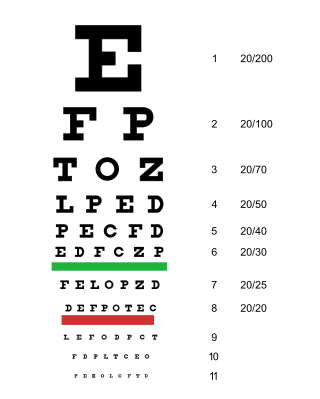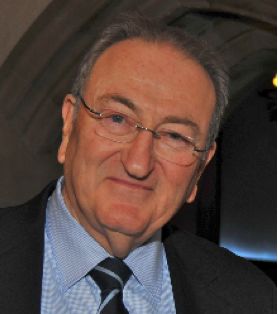Related Research Articles

Amblyopia, also called lazy eye, is a disorder of sight in which the brain fails to fully process input from one eye and over time favors the other eye. It results in decreased vision in an eye that typically appears normal in other aspects. Amblyopia is the most common cause of decreased vision in a single eye among children and younger adults.

Visual acuity (VA) commonly refers to the clarity of vision, but technically rates a person's ability to recognize small details with precision. Visual acuity depends on optical and neural factors. Optical factors of the eye influence the sharpness of an image on its retina. Neural factors include the health and functioning of the retina, of the neural pathways to the brain, and of the interpretative faculty of the brain.

An eye chart is a chart used to measure visual acuity comprising lines of optotypes in ranges of sizes. Optotypes are the letters or symbols shown on an eye chart. Eye charts are often used by health care professionals, such as optometrists, physicians and nurses, to screen persons for vision impairment. Ophthalmologists, physicians who specialize in the eye, also use eye charts to monitor the visual acuity of their patients in response to various therapies such as medications or surgery.

Béla Julesz was a Hungarian-born American visual neuroscientist and experimental psychologist in the fields of visual and auditory perception.

Visual or vision impairment is the partial or total inability of visual perception. For the former and latter case, the terms low vision and blindness respectively are often used. In the absence of treatment such as corrective eyewear, assistive devices, and medical treatment – visual impairment may cause the individual difficulties with normal daily tasks including reading and walking. In addition to the various permanent conditions, fleeting temporary vision impairment, amaurosis fugax, may occur, and may indicate serious medical problems.
Within computer technology, the gaze-contingency paradigm is a general term for techniques allowing a computer screen display to change in function depending on where the viewer is looking. Gaze-contingent techniques are part of the eye movement field of study in psychology.
Marlene Behrmann is a Professor in the Department of Ophthalmology at the University of Pittsburgh. She was previously a Professor of Psychology at Carnegie Mellon University. She specializes in the cognitive neuroscience of visual perception, with a specific focus on object recognition.

Stanley A. Klein is an American psychophysicist. He is Professor of Vision Science and Optometry at the University of California, Berkeley and a member of the Berkeley Visual Processing Laboratory. He was a consulting editor for Attention, Perception, & Psychophysics, a publication of the Psychonomic Society which promotes the communication of scientific research in psychology and allied sciences. His major area of research has been neurotechnology, a field of science that studies the body and mind through the nervous system by electronics and mechanisms. He was the co-chair for the SPIE meetings on human vision. Klein has authored and co-authored numerous papers on visual perception in the human brain. He is currently interested in the intersection of religion and science.
Jocelyn Faubert is a psychophysicist best known for his work in the fields of visual perception, vision of the elderly, and neuropsychology. Professor Faubert holds the NSERC-Essilor Industrial Research Chair in Visual Perception and Presbyopia. He is the director of the Laboratory of Psychophysics and Visual Perception at the University of Montreal. Professor Faubert has also been involved in the award-winning transfer of research and developments from the laboratory into the commercial domain. He is a co-founder and member of the Board of Directors of CogniSens Inc.
Michael Werner von Grünau was a Canadian psychologist and neurophysiologist at Concordia University.

Crowding is a perceptual phenomenon where the recognition of objects presented away from the fovea is impaired by the presence of other neighbouring objects. It has been suggested that crowding occurs due to mandatory integration of the crowded objects by a texture-processing neural mechanism, but there are several competing theories about the underlying mechanisms. It is considered a kind of grouping since it is "a form of integration over space as target features are spuriously combined with flanker features."

Martin Jeffrey Steinbach was an American vision researcher who spent most of his career in Canada. He was Distinguished Research Professor Emeritus in the Department of Psychology at York University. He received a master's degree from Connecticut College in 1965 and a Ph.D. from Massachusetts Institute of Technology (MIT) in 1968.

Vernier acuity is a type of visual acuity – more precisely of hyperacuity – that measures the ability to discern a disalignment among two line segments or gratings. A subject's vernier acuity is the smallest visible offset between the stimuli that can be detected. Because the disalignments are often much smaller than the diameter and spacing of retinal receptors, vernier acuity requires neural processing and "pooling" to detect it. Because vernier acuity exceeds acuity by far, the phenomenon has been termed hyperacuity. Vernier acuity develops rapidly during infancy and continues to slowly develop throughout childhood. At approximately three to twelve months old, it surpasses grating acuity in foveal vision in humans. However, vernier acuity decreases more quickly than grating acuity in peripheral vision. Vernier acuity was first explained by Ewald Hering in 1899, based on earlier data by Alfred Volkmann in 1863 and results by Ernst Anton Wülfing in 1892.

Davida Young Teller was a professor in the Departments of Psychology and Physiology/Biophysics at the University of Washington, Seattle, Washington. She was a leader in the scientific study of infant visual development.
Harry Helson was an American psychologist and professor of psychology who is best known for his adaptation-level theory. Most of his work and research focused on perception, with much of it involving the perception of color. His first published work was his doctoral dissertation on Gestalt psychology, which was published in the American Journal of Psychology in 1925 and 1926. Every year at Kansas State University, a graduate student receives the Harry Helson Award recognition of excellence in scholarship and research in cognitive psychology.
Matt McGue is an American behavior geneticist and Regents Professor of psychology at the University of Minnesota, where he co-directs the Minnesota Center for Twin and Family Research.
Siaufung "Bosco" Tjan was a Chinese-American psychologist and neuroscientist. He was a professor of psychology at the University of Southern California's Dornsife College of Letters, Arts & Sciences.

Louise Littig Sloan was an American ophthalmologist and vision scientist. She is credited for being a pioneer of the sub-division of clinical vision research, contributing more than 100 scientific articles in which she either authored or co-authored. Her most notable work was in the area of visual acuity testing where she developed and improved equipment. Sloan received her Ph.D. from Bryn Mawr College in experimental psychology. She spent a short period of time in both Bryn Mawr's experimental psychology program as well as the Department of Ophthalmology at Harvard Medical School. The majority of her career, however, was spent at Johns Hopkins Wilmer Eye Institute where she directed the Wilmer Laboratory of Physiological Optics for 44 years. In 1971, Sloan was the second woman awarded the prestigious Edgar D. Tillyer Award by Optica (formerly Optical Society for her many achievements in the field of vision.
Farley Norman is a professor of psychological sciences at Western Kentucky University. He is a co-director of the Gustav Fechner Perception Laboratory at Western Kentucky University, along with his wife, Hideko Norman.
The MNREAD acuity chart or Minnesota low vision reading chart is a text based chart used to measure near visual acuity in people with normal or low vision. It can also be used to measure maximum reading speed, critical print size and the reading accessibility index of a person. Digital and printed types of charts are available.
References
- Legge, G.E. (2007), Psychophysics of reading in normal and low vision, Hillsdale, NJ: Lawrence Erlbaum Associates.
- Mansfield J., Ahn, S., Legge, G.E., & Luebker, A. (1993). A new reading-acuity chart for normal and low vision. Ophthalmic and Visual Optics/Noninvasive Assessment of the Visual System Technical Digest, 3, 232–235.
- http://www1.umn.edu/twincities/index.php
- http://www.psych.umn.edu/psychology
- http://vision.psych.umn.edu/groups/gellab
- http://vision.psych.umn.edu/users/legge/index.html